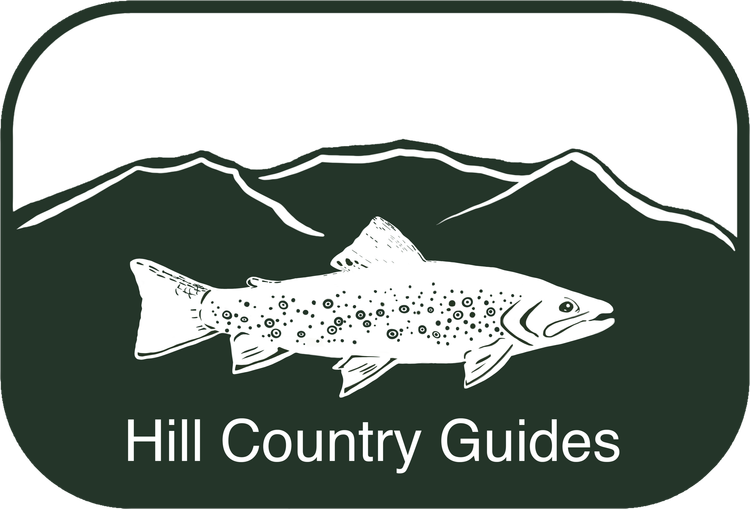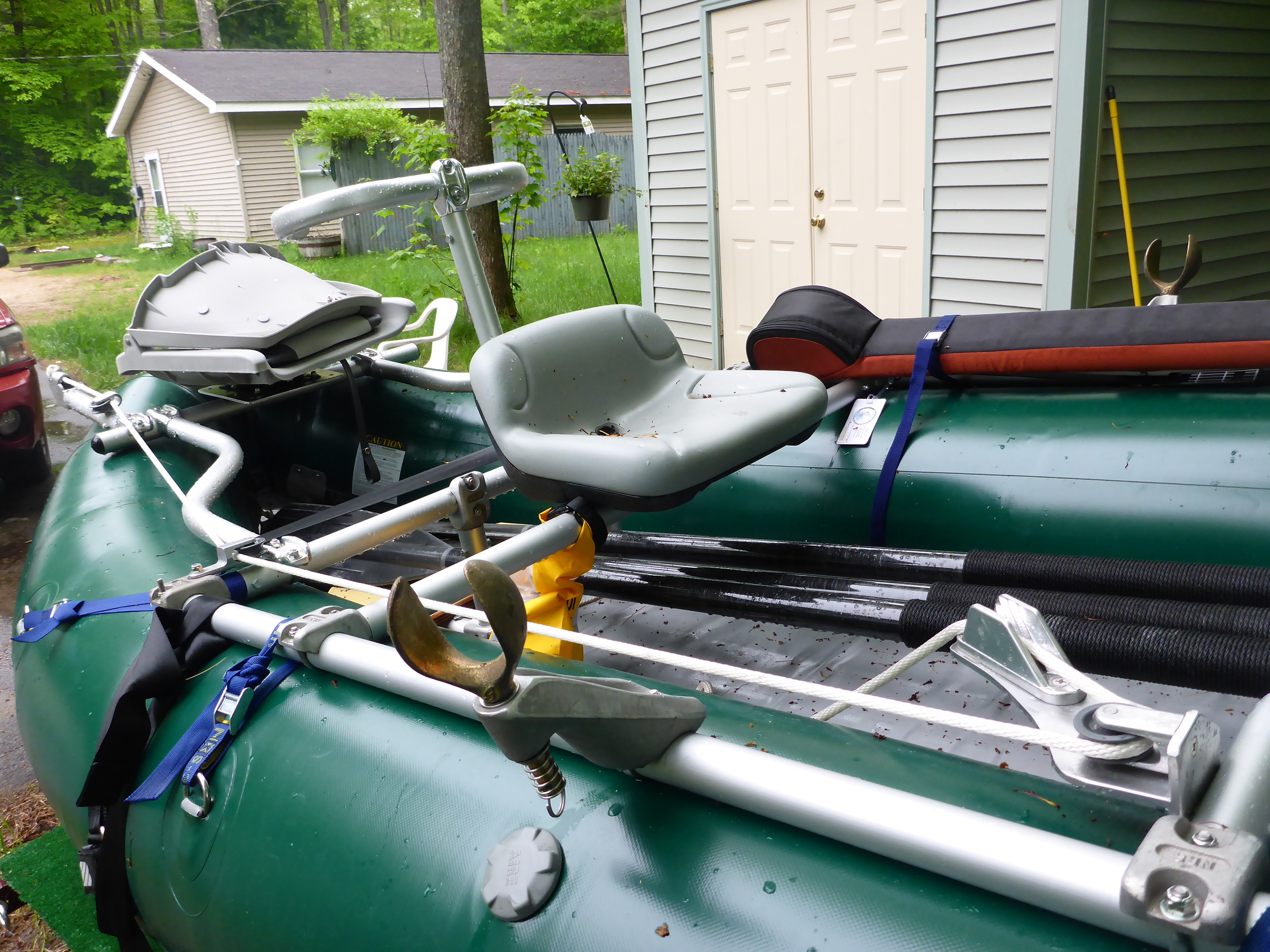Well it has been a while since I've had a chance to sit down and type a report. I have been guiding almost every day for the past few weeks. The fishing has been excellent on waters big and small, but for this report I will focus on the big. Last week I spent four straight days at the oars. I'll break this into chapters to make it more digestible.
Chapter one: The Connecticut: I had a trip up north with Greg from Lopstick lodge on Wednesday and I headed up a day early to scout the river. We ended up floating a lower stretch than the one we planned to guide on (a place where Greg wanted to try my raft). The fishing was sporadic throughout the float with a few fish missed from time to time. Then within a quarter mile of the takeout we began hooking up. I was at the oars when we came to a deep pocket off of a steep sandy bank. I yelled to Greg, CAST CAST RIGHT THERE. Of course Greg was already making the cast and when the fly hit there was a quick boil, his reel screamed. The fish burned line to the other side of the river and I quickly crabbed the boat to the other side. We landed the fish, a buttery hook jawed brown that measured 18.5 inches. I still need to ask Greg for the pictures. We hooked a few smaller browns and some wild rainbows before calling it a day. That night it began to rain. When we awoke at 5 am, the rain was coming down in sheets, things did not look good. We met our guests in Colebrook and suggested that Greg and I go take a look at the river before we made a decision on whether or not to proceed with the plans. As we drove over the Connecticut a skunk crossed the road, "That better not be a sign." Greg sulked.
We peered into the river. The water was an opaque brown. "This is the worst" Greg lamented, "There is just enough clarity to make me think, maybe we can catch some fish." "Yeah, and we don't know if it is going to get better or worse from here." I countered. We decided to tell the truth to our guests and leave the decision up to them. "It's a total crap shoot." Greg Explained. Mike the most adamant of our guests cut in first, "Well lets do this! I didn't come all the way to Northern NH to sit around in the rain."
To our pleasant surprise the trip went well. We got into fish right away above where one of the muddy tributaries entered. Then the fishing slowed through the middle of the day but we found rising fish again right before dark. It was a long twelve hour day on the oars and I had to be in Gorham for another drift the next day at 7 am.
Chapter Two: The Andro Luckily the Andro wasn't nearly as brown as the Connecticut and we found fish quickly below the put in. Dan got into the first fish, a 14 inch brown and his friend Claude quickly followed suit with a ten inch brown of his own. We hooked and lost fish on dry flies until lunch time and then the wind picked up and the fishing shut down for a while. Then towards the end of the trip we began hooking fish on streamers. A few of the missed fish looked to be trout but all that got to the boat were bass and fall fish.
Friday was another drift trip with Dave Peress a friend of my good friend Bob Mallard. We began fishing with nymphs and the first few fish were of the warmwater variety. I could tell that Dave was beginning to get discouraged and when he hooked a larger fish he immediately pronounced "Another Fallfish!" But I could see his rod thumping, the line beginning to zig and zag. "Are you sure?" I said, as I slid my net out from under the seat. Then a 14 inch rainbow shot into the air and threw the hook. "That was a trout!" Dave's focus increased. He landed the next rainbow that struck and then lost another larger one. We pressed downstream to some dry fly water. And I prepared lunch while Dave dealt with a conference call. We picked out a few rising fish while we ate and after lunch Dave fooled a wild rainbow and a good brown on dry flies.
We slid down to the next run and I had Dave start with a large streamer on the sinking line. As I secured the boat I heard a scream, I looked up to see Dave's rod bend to a C and throbbing. Suddenly the rod shot straight, "AAAHHHH that was a pig!" "Man what am I doing wrong today!" I tried to console him, "Most of these bigger fish are wild rainbows. They didn't get that big by getting caught." Dave fished the streamer for a bit longer and then we switched to a dry fly. We landed a brook trout and then lost a few smaller rainbows. So I decided to switch to a larger stonefly to see if something bigger would look up. On the second drift there was a bright silver flash. Then on the next drift a sliver torpedo shot downstream and bumped the fly, before turning away. After many more drifts he never came back. I surmised that he had probably seen us when he turned towards the fly.
We got back in the boat and threw streamers to the far bank,after a few fishless holes I decided to press back to the other side. I dragged the boat back upstream so that we could float the length of a long flat and fish the next right hand bank. I had Dave switch back to the stonefly with a heavy nymph dropper. We missed one swirl in the flat and then Dave hammered three browns in a row casting within a foot of the bank. We worked our way down to the next riffle and as I set the anchor a fish rose against the bank. Dave hooked the fish on the nymph, a fat twelve inch brown. We lost a few more on a royal coachman before moving on. We fished a few more spots and Dave caught another brown and a beautiful ten inch wild rainbow along with a four inch brook trout and a four inch rainbow ( a good sight to see).
Chapter Three: Charlie Lowe Although I should have headed straight home after a long four days on the water I couldn't help but stop at a long flat where I suspected there might be some wild rainbows rising right before dark. As I pressed through the woods to the river I saw a familiar figure. It was Charlie Lowe long time local and former river guide. "What are you doing here?" Charlie joked. "Same thing you are, waiting for the fish to rise." I didn't have a rod with me and I was content to watch Charlie fish. "Well they aren't here now." "Oh they will be here Charlie."As we waited for the fish I asked Charlie questions about the rivers history. He talked about how good the fishing once was. About spots downstream and up where he had landed trout over thirty inches. About a monster that his father had caught when he was a boy, "When placed head first in an oil drum, his tail still stuck out over the top, That fish must have gone over forty inches." he remembered. I asked Charlie where he thought those big fish had gone and he had a dozen or so theories. We both agreed that there were too many possibilities to know for sure. "I just hope that this river comes back to her former glory." Charlie sighed.
As we stared into the river a fish rose. Charlies, eyes lit up, "I guess I'd better put on a dry fly." In near darkness he fastened a size sixteen Grey caddis, "All you need on this river is a woolly bugger and a grey caddis." he explained. Then Charlie made his first cast of the evening. There was a quick splash and a hookset, a twelve inch rainbow danced in the air. He slid the fish in and I did the honors of unhooking it. You could still see the parr marks on the fish's sides, "You can tell that fish didn't come from no hatchery." Charlie explained. Then he made another cast. The fly drifted and then swung, a fish struck, Charlie set, and the line snapped. He turned to me,"Ohhhh, that was a fish." It was now almost completely dark, so I offered to tie the fly on. Charlie continued to fish, but the rises were diminishing. "I guess that's it" Charlie said. He made one turn of the reel handle and his rod jolted down, the reel screamed. "AHHHaaa" The fish made four or five solid 100 foot runs before it lay at our feet, a sixteen inch, chrome rainbow. As we slid the fish back to the river, I could see hope in Charlies eyes.
The next night I returned with rod in hand. Charlie helped me land an eighteen inch wild rainbow. It was my turn he said.



























